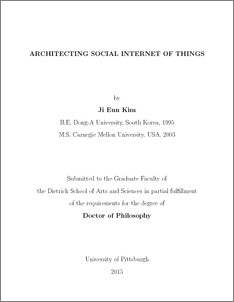Kim, Ji Eun
(2016)
Architecting Social Internet of Things.
Doctoral Dissertation, University of Pittsburgh.
(Unpublished)
![[img]](http://d-scholarship.pitt.edu/style/images/fileicons/application_pdf.png)  Preview |
|
PDF (2nd revision after Philippa's review)
Updated Version
Download (5MB)
|
Abstract
In the new era of the Internet of Things (IoT), most of the devices we interact with daily are connected to the Internet. From tiny sensors, lamps, home appliances, home security systems and health-care devices, to complex heating, ventilation and air conditioning (HVAC) systems at home, myriad devices have network connectivity and provide smart applications. The Social Internet of Things (SIoT) is a new paradigm where IoT merges with social networks, allowing people and connected devices as well as the devices themselves to interact within a social network framework to support a new social navigation. Smart homes is one of the domains that can fully leverage this new paradigm, which will enable people and devices, even in different homes, to actively and mostly automatically collaborate to discover and share new information and services. Unfortunately the heterogeneous nature of the devices around the home prohibits seamless communication in the (S)IoT. Furthermore, the state-of-the-art solutions in smart homes offer little, if any, support for collaborating users and devices. This dissertation describes a new, scalable approach to connect, interact and share useful information through devices and users with common interests. The dissertation has three contributions. First, it proposes a holistic and extensible smart home gateway architecture that seamlessly integrates heterogeneous protocol-- and vendor-- specific devices and services and provides fine-grained access controls. Second, it defines an interoperable, scalable and extensible software architecture for a novel cloud-based collaboration framework for a large number of devices and users in many different smart homes. Third, it provides a reasoning framework to enable automated decisions based on the discovered information and knowledge created and shared by end users. The developed architecture and solutions are implemented in real systems, which integrate with many different devices from different manufacturers and run multiple categories of rules created by end users. The architectural evaluation results show the developed systems are interoperable, scalable and extensible.
Share
| Citation/Export: |
|
| Social Networking: |
|
Details
| Item Type: |
University of Pittsburgh ETD
|
| Status: |
Unpublished |
| Creators/Authors: |
|
| ETD Committee: |
|
| Date: |
20 January 2016 |
| Date Type: |
Publication |
| Defense Date: |
23 November 2015 |
| Approval Date: |
20 January 2016 |
| Submission Date: |
4 December 2015 |
| Access Restriction: |
1 year -- Restrict access to University of Pittsburgh for a period of 1 year. |
| Number of Pages: |
132 |
| Institution: |
University of Pittsburgh |
| Schools and Programs: |
Dietrich School of Arts and Sciences > Computer Science |
| Degree: |
PhD - Doctor of Philosophy |
| Thesis Type: |
Doctoral Dissertation |
| Refereed: |
Yes |
| Uncontrolled Keywords: |
internet of things, social internet of things, smart home, software, reasoning, end-user programming |
| Date Deposited: |
20 Jan 2016 18:59 |
| Last Modified: |
20 Jan 2017 06:15 |
| URI: |
http://d-scholarship.pitt.edu/id/eprint/26592 |
Metrics
Monthly Views for the past 3 years
Plum Analytics
Actions (login required)
 |
View Item |








